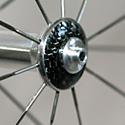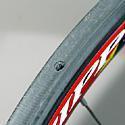
Recently on Cyclingnews.com |
Review - August 5, 2004
Wonder wheels
Zipp 303 tubular wheels
Expecting that there'd be a serious downside to a pair of wheels that offered low weight, easy maintenance and comfort, Jon Devich is startled to discover that the only thing he can find to complain about is the price.
 |
I've always thought there was something wonderful about bike wheels. It's the way such a minimal structure can take so much load, plus the pounding handed out by bike racers belting them over pot-holed roads, hammering them in sprints and generally dishing out standard abuse. When I was still working in a shop I had to have every new wheel combination I could come up with. I'd build up different hubs, rims or spoke patterns just to try something different. So you can imagine my excitement when I pulled out of the box a shiny new pair of Zipp 303s.
Zipp claims a pair of 303s weighs 1124 grams, and for once, this is exactly what we find. (Wheel - and especially rim - weights are notoriously variable because of the manufacturing variances of extruded rims, but that's not an issue for Zipp and the claimed weight was spot on.) What is included in these 1124 grams are a rear hub at 202 grams and front at 84 grams. Rims are 38mm deep hoops, described by Zipp as "ICT Carbon/Graphite composite rims with Silica ceramic braking surfaces." Spokes are made by Sapim with the front using 20 and rear 28. Rear cassette bodies are available in either Shimano or Campagnolo compatible versions.
|
|
|
|
|
|
|
|
|
The first things that hit you about these wheels are their looks and the lack of weight. Lighter tubular wheels exist, but they're usually intended for limited special purposes such as hill climbs or attracting attention at bike shows. 303s, on the other hand, are all-round racing wheels and their lack of weight has to be a good thing - for most people. I weigh in at a svelte 215 pounds, however, and have ruined many wheels because of it so the 303s low gram count made me a bit nervous. The notion of carbon rims is a slightly worrying one too but technology has come a long way so I figured we'll see how they go.
Before I get into the actual road review I want to talk about the construction of the hubs. Both front and rear hubs are very simple with a basic hub body, pressed in bearings, alloy axles and beautiful carbon bearing dust covers. This simple approach makes it extremely easy to perform the limited maintenance if any that would need to be done on a hub. With an Allen wrench set I had the front hub apart in about 30 seconds. The rear hub is just as easily broken down even with the free-hub body involved. To me this is a welcome change from the many complicated products that have to be returned to the dealer just for a simple cleaning.
On to the road. The 303s went into an aluminium-framed bike with a titanium seat post that usually transmits every bump and ripple straight up to the rider - the kind of bike where you go over a coin and you can tell whether its heads or tails. The 303s make a dramatic, immediately noticeable difference to the ride, smoothing out vibration and comfortably isolating the rider from the rough road. This would be great for longer rides but was there an impact on wheel stiffness? The area I ride has lots of big rollers so between those and sprinting with my weight a flexible wheel is basically useless and does not last long.
Much to my surprise and excitement this turned out not to be an issue at all. The first climb on the 303s was pretty startling. There was none of the flex that I was expecting; accelerating with the Zipps felt very snappy whether I was on the flats or climbing. Standing up on the pedals with these wheels makes the bike go without any hesitation whatsoever. Cornering and descending felt equally as stable with the lateral stiffness especially welcome in high-speed conditions. With no downside, I relaxed and enjoyed the bit of extra comfort on longer rides provided by the road isolation of the carbon rims.
Braking is an area that raises criticisms for carbon rims. Because carbon conducts heat away from the brake pads less well than aluminium, and has different frictional properties, some carbon rims just don't stop very well with standard brake pads. Zipp uses a silica-ceramic coating on its braking surfaces and recommends the use of its own Carbon/Carbon brake pads. As it happens I found stopping in dry conditions with regular pads was excellent, and as I live in the Arizona desert, the issue of wet-weather performance didn't arise. Standard pads do wear very quickly with the 303s, though, so it's sensible to follow Zipp's advice.
At around $1350 per pair, these wheels are by no means cheap, but that's the only thing I can find to criticise about them. This was my first experience with carbon-rimmed wheels so maybe others are just as good - and the 303s were excellent. I want wheels to be light, stiff and to holds up to my use, and my 215lbs. The Zipps are all this and more.
Recommended retail price: US$1350/pr
Weight: 1124g/pr
Pro: Light weight, fast accelerating, good looks, stiff
Con: Price (These are great wheels for the money but $1000+ is still
a lot for a pair of wheels)
More information: Zipp's
website
Cyclingnews Rating: ![]()






